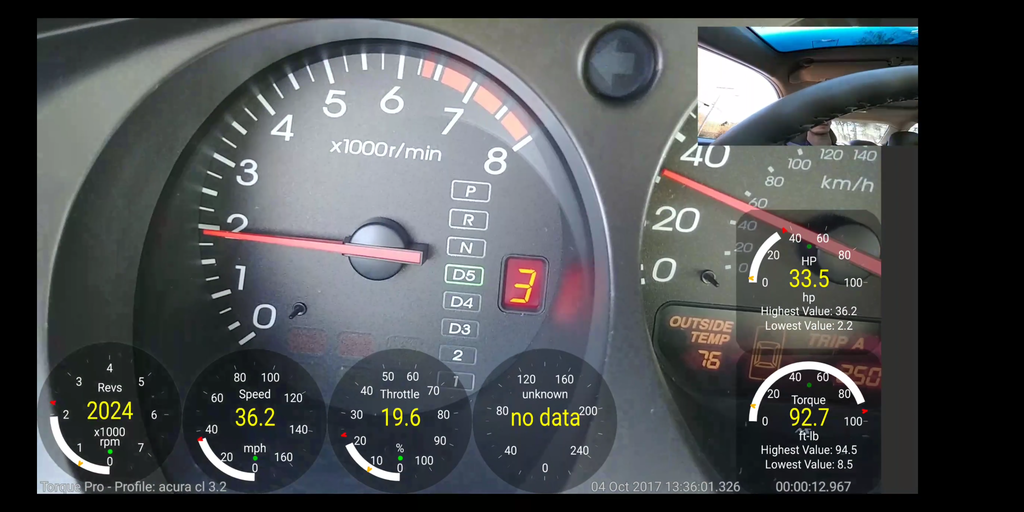

|
| Search | Car Forums | Gallery | Articles | Helper | AF 350Z | IgorSushko.com | Corporate |
|
| Latest | 0 Rplys |
|
|||||||
 |
 Show Printable Version | Show Printable Version |  Email this Page | Email this Page |  Subscribe to this Thread
Subscribe to this Thread
|
|
|
Thread Tools |
|
|
#1 | |
|
AF Newbie
Join Date: Oct 2017
Location: Lowell, Massachusetts
Posts: 3
Thanks: 0
Thanked 0 Times in 0 Posts
|
what causes RPM's to change in while in gear?
https://youtu.be/Q-aUBeRxX5k
Video of explanation When in gear and apply more throttle the rpms will jump up by 500 I have a 2001 acura CL. When I use the sequential sports shift and apply more throttle the RPMs raise by about 500. Say I am in 3rd gear, 2,000 rpm @ 30 mph. When I step on the gas the rpms will go to 2,500 instead of a steady gradual climb from 2,000. 3rd gear @ 3,000rpm is approximately 50 mph. But when I step on it the rpms will go higher than what it should be in that gear at that speed. Same with 4th gear, I could be going 30 mph at 1250 rpm. When I give it more that 25% throttle the rpms will go up to 2,000 and then slowly drop. 2,000 rpm in 4th is 50 mph however I might only be pushing 35-40 at that same rpm. What causes this to happen? Is it the torque converter lock up area or something to do with a 1 to 1 ratio between the engine and transmission? I'm curiouse as to why this is and would this be the case in a manual transmission? Thank you In these pictures, speed is the same, throttle and rpm is greater URL=http://s38.photobucket.com/user/MangoBS4/media/Screenshot_2017-10-05-02-57-56_zps5sf2ojeg.png.html]  [/url] [/url] Last edited by mangobs; 10-05-2017 at 04:11 AM. Reason: added photo |
|
|
|

|
|
|
#2 | |
|
AF Regular
Join Date: Aug 2004
Location: Farmersville, Texas
Posts: 267
Thanks: 32
Thanked 9 Times in 9 Posts
|
Re: what causes RPM's to change in while in gear?
I think what you are asking about, is called converter slippage. Which is perfectly normal. A torque converter does not lock up solid like a manual clutch, (except when it is a lockup converter, and all of the operating conditions have met the programmed parameters in the PCM). So, excluding the topic of lockup converters, any T.C. is actually a "fluid clutch", and by their nature, the more torque you put into it, the more it will slip. Which also multiplies the torque. Think of it this way: Say your engine has a powerband that makes peak torque at 4,000 RPM, and peak HP at 5,000 RPM. If your converter didn't allow the slippage to enable higher engine RPM at full throttle, your car would be a turd when trying to accelerate. Say you were in 3rd gear at 40 MPH, and your engine is at 2500 RPM, and you enter a highway on-ramp, and step on the gas to get up to speed. Your engine might only make half as much power at 2500 RPM as it does at 5,000. So your car would accelerate very slowly, and it would not allow you to use the full amount of power your engine is capable of making. But if your converter was extremely "loose", so that you were at 4 or 5,000 RPM while cruising at 1/4 throttle, your fuel mileage would suck, and trans fluid would get very hot. It is a compromise, which allows you to cruise and get decent mileage, but still accelerate when you need to. And if a converter didn't slip at all, ever, you could not sit at a red light in gear. It's job in that situation is to let the engine keep turning, while the transmission output shaft is stopped. This is a simplified explanation, I hope it helps. What you are seeing is normal.
__________________
-Jim 2015 Silverado Crew Cab 2500HD 6.6 Duramax 4x4 2002 Silverado Crewcab HD 2500 6.0 4x4 Sold 281K Great Truck 1970 Chevelle SS454 (Gave to my son 9 years ago for his 18th birthday. Yeah, I know, crazy, right? Thank goodness he doesn't drive it the way I would, -er, did...).  1971 Monte Carlo SS454 Drag Racer. The old girl finally got new paint! 1968 Camaro SS (New race car project). Caged, Tubbed, Back-Half/Ladder Bars. Rolling Chassis (For now). |
|
|
|

|
|
 |
POST REPLY TO THIS THREAD |
| Tags |
| converter , gears , rpm , torque |
 |
|
|